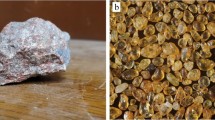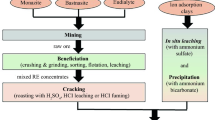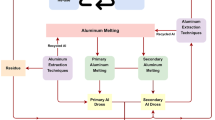Aversion is proposed for chemical and mineral classification of technogenic refractory raw material. Secondary mineral resources are considered of essentially silica composition represented by four large-scale technogenic formations.Waste-free technology is developed for processing sub-standard material with preparation of enriched raw material for producing quartzite filler grade ZVK-97, building gravel, and sand. The suitability is established for the fine-grained fraction of silica waste (enrichment tailings) for preparing molding, filter, building materials, and also in a raw material for producing some grades of packaging glass and other materials. The possibility is demonstrated of using regeneration products of exhausted molding mixes for preparing high quality dinas. Microsilica is studied comprehensively, on whose basis promising areas for its utilization are developed.





Similar content being viewed by others
References
V. A. Perepelitsyn, I. V. Yukseeva, and L. V. Ostryakov, “Ural technogenic raw material for refractory manufacture,” Ogneupor. Tekhn. Keram., No. 6, 50 – 54 (2009).
V. A. Perepelitsyn, V. M. Rytvin, V. A. Koroteev, et al., Ural Technogenic Raw Material [in Russian], UrO RAN, Ekaterinburg (2013).
V. A. Perepelitsyn, V. M. Rytvin, S. I. Gil’vara, et al., Ferroalloy Aluminothermal Slags [in Russian], Ural. Rabochee, Ekaterinburg (2014).
V. A. Perepelitsyn and F. A. Tabulovich, “Mineral raw material base of Pervoural; Dinas Plant (OAO Dinur) and areas of its rational use,” Mineral Syrr’e Urala, No. 5.6 (13) 3 – 29 (2007).
V. G. Flyagin, L. I. Solodova, S. D. Gamzikova, et al., “ Using slate quartzite for making fillers for monolithic linings of steel-casting ladles,” Refractories, 28(5), 258 – 260 (1987).
V. A. Perepelitsyn, L. A. Karpets, L. A. Rechneva, et al., “Mineral composition of the quartzites and enclosing rocks of the Karaul’naya deposit,” Refract. Indus. Ceram., 38(5), 197 – 202 (1997).
V. A. Perepelitsyn, I. V. Yukseeva, K. A. Maksunov, et al., “Geochemical features of quartzites of the Karaul Mountain deposit (South quarry),” Refract. Indus. Ceram., 49(2), 103 – 107 (2008).
Z. G. Ponomarenko, A. L. Rechneva, F. L. Kapustin, et al., “Use of spent molding sand in the production of refractories,” Refract. Indus. Ceram., 57(2), 132 – 134 (2016).
V. A. Perepelitsyn, M. N. Dunaeva, K. A. Maksunov, et al., “Microsilica — a polyfunctional technogenic raw material,” Proc. Internat. Conf. Refractory Workers and metallurgists (14 – 15 March 2013, Moscow), Novye Ogneupory., No. 3, 32 (2013).
Author information
Authors and Affiliations
Corresponding author
Additional information
Translated from Novye Ogneupory, No. 5, pp. 7 – 16, May, 2017.
Rights and permissions
About this article
Cite this article
Perepelitsyn, V.A., Kapustin, F.L., Ponomarenko, A.A. et al. Secondary Mineral Resources for Refractory Manufacture. Part 1. Silica Technogenic Materials. Refract Ind Ceram 58, 259–268 (2017). https://doi.org/10.1007/s11148-017-0094-z
Received:
Published:
Issue Date:
DOI: https://doi.org/10.1007/s11148-017-0094-z




